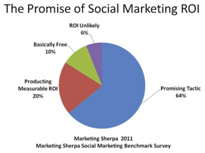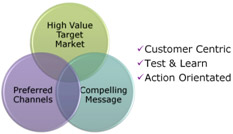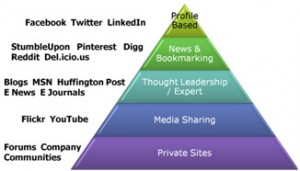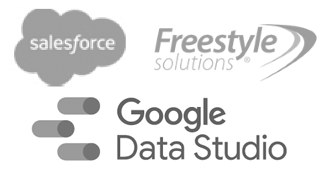Many of you know that I am an Adjunct Professor in CRM at the Carey Business School of Johns Hopkins Univ. I have invited a fellow instructor and colleague – Randy Hlavac, a Lecturer Professor of Integrated and Social Marketing at Northwestern’s Medill IMC program – to share his very excellent thinking on Social Media ROI.
Please feel free to give us your thoughts on this guest blog:
Bruce Gregoire kindly asked me to provide a guest blog posting on our recent success with tracking ROI on social media initiatives. This is my first of two blog articles – covering the misconceptions of social media and social marketing. The next will discuss how to transform your social programs into measurable, testable & more successful marketing programs.
I teach social marketing in the graduate and undergraduate marketing programs in the Medill IMC College at Northwestern. While there are thousands of pundits who recommend marketing on Facebook, Twitter, PInterest, LinkedIn or the thousands of other social sites, we have found this is the wrong way to go. It’s not successful to focus on these social channels but to focus on marketing using social media. In other words, it’s focusing on marketing – not media.
Most companies are “lost” in social media
 In a 2011 survey by Marketing Sherpa, they surveyed over 3000 B2B and B2C marketing managers and found over 80% of them have no way of measuring the bottom line impact of their social marketing programs. They can measure growth in friends, re-tweets, thumbs up or whatever, but they cannot show these activities are actually increasing the profits of the company. They cannot determine if these social visitors are customers they already have, prospects they would like to develop, or just other low potential prospects. Furthermore, if they are customers, they cannot tell if the social interactions strengthen the relationship and, if they do, by how much. Social marketing today is primarily done on “faith and hope”…which is not a very good way to run a company.
In a 2011 survey by Marketing Sherpa, they surveyed over 3000 B2B and B2C marketing managers and found over 80% of them have no way of measuring the bottom line impact of their social marketing programs. They can measure growth in friends, re-tweets, thumbs up or whatever, but they cannot show these activities are actually increasing the profits of the company. They cannot determine if these social visitors are customers they already have, prospects they would like to develop, or just other low potential prospects. Furthermore, if they are customers, they cannot tell if the social interactions strengthen the relationship and, if they do, by how much. Social marketing today is primarily done on “faith and hope”…which is not a very good way to run a company.
 Better understand what marketing is and you can create an effective social marketing strategy
Better understand what marketing is and you can create an effective social marketing strategy
When I teach social marketing, I “force” the grad students to discuss – in great detail – the IMC marketing model. While I will not make you do it, I use the model to establish the following points:
- The IMC marketing model starts with a high value market – For success, you must connect by targeting each market with the products, services, messages, and information they find important. And each market has a different message. If you don’t start with markets, you will not have success in your social [or any other] program.
- Messages and Channels must be the ones preferred by the high value target market – These two elements must be selected and built to the desires and preferences of the high value target market. Don’t offer the right product with the right message: forget it. Offer it in a channel they don’t use [like direct mail for younger people]: forget it. They must align.
- Success occurs in the overlap of the 3 circles – This is where the ‘magic’ happens. You must have all three synchronized [integrated?] to have a successful program.
In addition to having marketing programs which are built on the IMC marketing model, each of your marketing programs – including your social marketing programs – must meet several other criteria. They must be:
- Significant – they must produce significant bottom-line results for senior management to consider and fund them
- Able to be replicated – our marketing programs must allow marketers to re-use the strategy to further grow market share
- Testable – we need to be able to test and learn on every aspect of our marketing program
- Customer-centric – they must acknowledge the customer relationship and grow it from first order to last.
Why is this important? We must have social programs which meet these marketing essential criteria. How do we do that? We must not focus on Facebook or Twitter or whatever and focus on how to make social a marketing weapon for our company. And, to do that, we need to better understand what social is…and it’s a lot more than Facebook and Twitter.
What makes social unique?
In my new book – Social IMC [to be published soon] – there are three concepts often misunderstood by marketers. Better understand these three concepts and you can develop a strategy to build a social program with ROI [bottom-line impact].
- Social Networks are different than social communities
Social networks are sites like Facebook, Twitter, LinkedIn, and others. They consist of individuals who are discussing everything “under the sun”. There are people talking about every topic, every company, and everything else. Marketers often start with these social networking sites because it is intuitive potential markets are there and it is easy to get started. You can create a Facebook site in minutes and be attracting followers a few minutes later. Simple, easy, and wrong.Social networks are great places to talk to everyone but not for marketing. Because marketing requires you to give a targeted message it means you must 1] understand who they are, 2] have a way to address their needs, and 3] be able to talk with them in a controlled way. NONE of these attributes is available on Facebook or other social networking sites. As you meaningfully talk to one person, others with different interests “go away”. You cannot make a sale here. HOWEVER, you can use these social networks to segment and engage key high value markets…provided you take them somewhere where you can talk to them in a controlled conversation.Social communities are PRIVATE sites [you must register with them] that are discussion specific topics. These are generally self-formed by community members and are focused on key topics of interest to the community. If you want to see some social communities, take a look at the American Express Members Project or Ridgid Tool’s plumbing forum. This type of system – a private community – is a key to using social media successfully. These types of community systems are places where people discuss their needs and wants and look for experts to help them address them. If you become a trusted expert in a high value community, you can “be there” when they are ready to buy.  Social Communities exist on many levels
Social Communities exist on many levels
While many marketers focus their social strategies on Facebook and Twitter, these are very small sites when you look at social media worldwide. The key is to understand EVERY social community engages on multiple levels. They do cruise on Facebook, Twitter & LinkedIn to hook up with others like them. They use News and Bookmarking sites to get more focused on their passions and needs. Bloggers are often thought leaders and trusted experts within a community. While communities to write articles, they also use video [and you should to] to present ideas and responses. Finally, the biggest place they dwell is in private communities. As you build a social marketing strategy, you need to engage your high value markets WHEREVER they are in the social “cloud”.- Private Sites dwarf Social Networks
The most common misunderstanding is social networks are the “place to be” in social. While you do need to be visible on Facebook, LinkedIn, Twitter and other social networks, these are to respond to questions and show different markets places where you are addressing their specific needs. I think of social networks like an inbound telecenter. The telecenter takes calls in the order they come in and attempts to address the questions of the caller. The same is true for social networks.
Think marketing strategies not social sites strategies
This lays the foundation of what makes social marketing different from social media strategies. Before the last ‘installment’ of this two part blog, think about the following questions:
- What are your high value markets?
- What types of non-social media do they read or consume?
- What type of social sites are they likely to use?
We will address the importance of these questions in the last ½ of this social marketing blog.
 Randy Hlavac is CEO and founder of Marketing Synergy Inc – an integrated and social marketing company located in Naperville IL. Founded in 1990, Marketing Synergy works with companies to build measurable, highly profitable marketing programs and the database and analytical systems to drive them. Randy works with B2B and B2C organizations ranging from start-ups to Fortune 100 firms. In addition to Marketing Synergy, Randy has been a Lecturer Professor of Integrated and Social Marketing at Northwestern’s Medill IMC program for the last 21 years. His graduate and undergraduate courses focus on the development of high impact Social IMC marketing programs and many of the course “graduates” work in social marketing today. Dialog with Randy on Twitter @randyhlavac or discuss social issues with this hash tag #NUSocialIMC. Randy can also be reached through his company website.
Randy Hlavac is CEO and founder of Marketing Synergy Inc – an integrated and social marketing company located in Naperville IL. Founded in 1990, Marketing Synergy works with companies to build measurable, highly profitable marketing programs and the database and analytical systems to drive them. Randy works with B2B and B2C organizations ranging from start-ups to Fortune 100 firms. In addition to Marketing Synergy, Randy has been a Lecturer Professor of Integrated and Social Marketing at Northwestern’s Medill IMC program for the last 21 years. His graduate and undergraduate courses focus on the development of high impact Social IMC marketing programs and many of the course “graduates” work in social marketing today. Dialog with Randy on Twitter @randyhlavac or discuss social issues with this hash tag #NUSocialIMC. Randy can also be reached through his company website.









